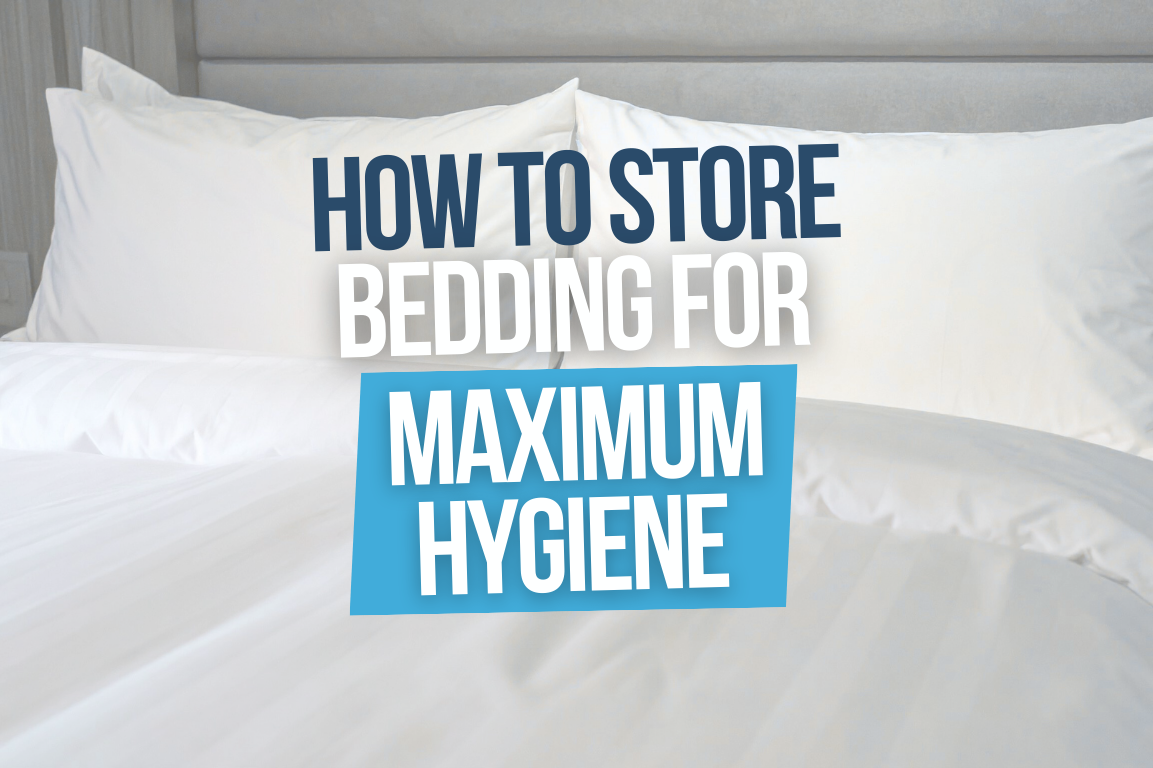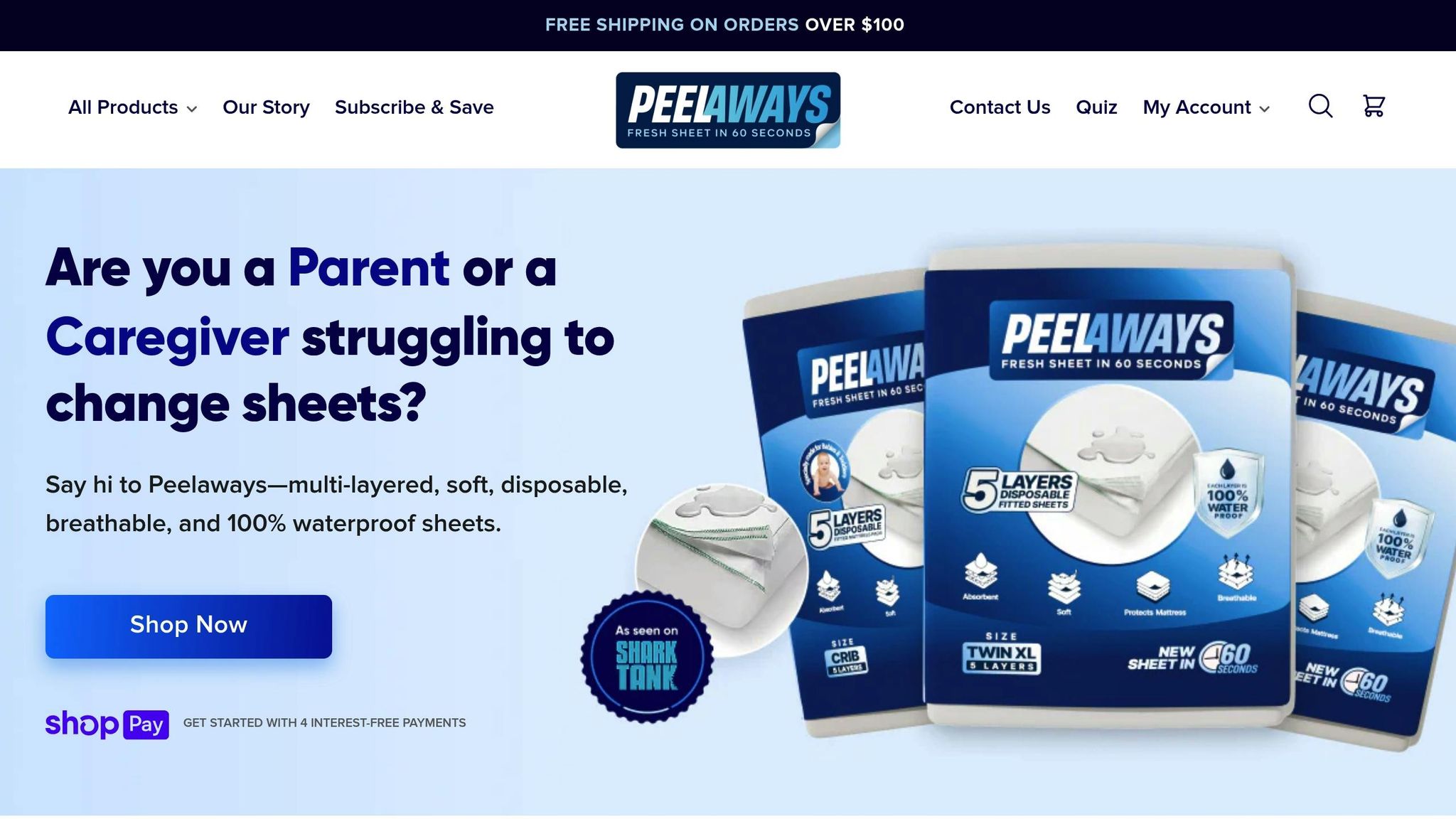How to Store Bedding for Maximum Hygiene

Storing bedding properly isn’t just about keeping things neat - it’s about maintaining hygiene and protecting your health. Improper storage can lead to mold, bacteria, and unpleasant odors, even if your sheets are freshly washed. Here’s a quick breakdown of what you need to do:
- Wash and Dry Thoroughly: Use the right water temperature and detergents for your fabric type. Ensure items are completely dry to prevent mold.
- Choose Breathable Storage: Opt for cotton or mesh bags to allow airflow and avoid moisture buildup. Skip plastic bags and cardboard, which trap humidity.
- Control Storage Conditions: Keep bedding in a cool, dry space with stable temperatures (68–75°F) and low humidity (40–57%). Use silica gel packets and natural pest repellents like cedar or lavender.
- Inspect and Rotate: Check for stains, tears, or damage before storage. Rotate your bedding sets regularly to ensure even use.
- Consider Disposable Options: For high-hygiene needs, disposable bedding like PeelAways sheets offers a practical, easy-to-use alternative. They feature multiple waterproof layers and eliminate the need for washing.
How to Store Linen in Airbnb (Step by Step)

Step 1: Clean and Prepare Bedding Before Storage
Properly cleaning and prepping your bedding is the first step to keeping it fresh and safe during storage. Even if your sheets and comforters seem clean, they can still harbor dust mites, bacteria, and allergens. A thorough wash, careful drying, and a close inspection will help ensure your bedding stays in top condition.
Washing the Right Way
Start by choosing the correct water temperature for your bedding. For cotton and linen sheets, hot water works best to kill bacteria and dust mites. On the other hand, delicate fabrics like silk or bamboo should be washed in cold water to maintain their quality. Synthetic blends typically perform well in warm water.
If you're dealing with protein stains, such as sweat or food spills, an enzyme-based detergent can help break them down. For households with sensitive skin or allergies, opt for hypoallergenic detergents. Avoid using fabric softeners on bedding with moisture-wicking or antimicrobial properties, as these can reduce their effectiveness.
Select the wash cycle based on the item's needs. Heavy-duty cycles are great for bulky comforters or heavily soiled bedding, while normal cycles work fine for everyday sheets. For delicate items like silk or vintage linens, stick to gentle or delicate cycles. Always wash similar colors together and avoid overloading the machine to ensure everything gets cleaned properly.
For stubborn stains, pre-treat them before washing. Baking soda paste works wonders on general stains, hydrogen peroxide is effective for bloodstains, and dish soap can tackle oil-based marks. Once washed, make sure everything is fully cleaned and ready for drying.
Drying Done Right
Proper drying is just as important as washing. Even a tiny bit of leftover moisture can lead to mold or mildew during storage. Thicker items like comforters or duvet covers are especially prone to retaining moisture in their centers, so double-check these.
Match the heat settings to the fabric type. Cotton and linen can usually handle higher heat, which also helps kill any lingering bacteria. Synthetic materials, however, should be dried on a lower heat setting to prevent damage. For delicate fabrics like silk or bamboo, air-drying is the safest option to preserve their texture and durability.
Air-drying has its perks - besides being gentle on fabrics, it can save energy. If the weather allows, hang your bedding outside on a clothesline. Sunlight not only dries items but also offers natural antibacterial benefits. If drying indoors, ensure good air circulation, especially for thicker items, to avoid any damp spots.
Before storing, inspect heavy areas for any leftover moisture to prevent musty smells or mold.
Inspect for Stains and Damage
Once your bedding is clean and dry, give it a final check under good lighting. Look for stains, small tears, loose seams, or worn patches. Even minor stains can get worse over time and attract pests, while small tears might grow as the bedding is folded or stacked.
Fix any issues right away. Sew loose buttons on duvet covers, patch small tears with matching thread, and replace worn elastic on fitted sheets. This ensures your bedding stays functional and ready for use.
Decide what to do with damaged items. Lightly stained or slightly worn sheets might still work for guest rooms or occasional use. Heavily damaged items, however, could take up unnecessary space. Consider repurposing old bedding as cleaning rags or donating pieces that are still in decent shape but no longer meet your needs.
Step 2: Choose the Right Storage Containers
The wrong storage containers can lead to moisture buildup, unpleasant odors, mold, and even fabric damage. To keep your linens fresh and safe from the issues mentioned earlier, it’s crucial to pick containers that provide protection and proper ventilation. Let’s explore how to select the best options for your bedding.
Opt for Breathable Storage Solutions
Breathable containers, like cotton storage bags, allow air to circulate around your linens. This airflow helps prevent moisture buildup, which is often the culprit behind mold, mildew, and bad odors. For smaller items, such as pillowcases, mesh laundry bags are a fantastic choice. Their open weave design promotes constant airflow while keeping your items organized and free from dust.
The key advantage of breathable storage is its ability to let any residual moisture escape, reducing the risk of mold and mildew.
Avoid Plastic Bags, Plastic Bins, and Cardboard
Non-breathable options, such as plastic bags, plastic bins, and cardboard boxes, are best avoided. These materials trap moisture, creating a perfect environment for mold and mildew. Cardboard, in particular, is problematic - it absorbs moisture, attracts insects, and contains acids that can discolor fabrics over time.
| Storage Type | Moisture Control | Pest Resistance | Fabric Impact |
|---|---|---|---|
| Cotton Bags | Excellent | Good (with natural repellents) | Keeps fabric protected |
| Mesh Bags | Excellent | Good | Preserves fabric quality |
| Plastic Bags | Poor | Poor | May degrade fibers |
| Cardboard Boxes | Poor | Prone to insect issues | Can cause discoloration |
Special Care for Delicate Bedding
Delicate fabrics and heirloom linens need extra attention. Store these items in breathable cotton storage bags to ensure proper airflow and minimize moisture-related risks. To add an extra layer of protection, include natural pest repellents like cedar balls or lavender sachets. This approach not only keeps your bedding safe but also ensures everything stays fresh and well-organized.
Step 3: Find the Best Storage Location
Once your bedding is clean and packed in the right containers, the next step is finding a storage spot that keeps it fresh and protected. The key here is to choose a location with stable temperature and humidity levels. Even the best containers can't fully shield your linens from the effects of dampness, fluctuating temperatures, or poor airflow. A well-ventilated area with consistent conditions is essential for long-term preservation.
Maintain Proper Temperature and Humidity
Temperature and humidity control play a big role in keeping your bedding in great shape. Fluctuations can lead to mold, mildew, and bacteria growth.
"Ideally, aim for a storage area that maintains a temperature between 60°F to 75°F and has low humidity levels." – Heat Holders® [1]
For the best results, store bedding in a space where the temperature stays between 68°F and 75°F, with humidity levels between 40% and 57%. If you’re dealing with a moisture-prone environment, consider using a climate-controlled space or a portable dehumidifier to maintain these conditions.
Add Moisture and Pest Protection
A little extra protection can go a long way in keeping your bedding fresh. Silica gel packets are great for absorbing moisture inside storage containers. To ward off pests and keep things smelling pleasant, try natural repellents like cedar blocks, lavender sachets, or dried herbs such as rosemary, mint, or bay leaves. Just remember to replace these every 6 to 12 months to keep them effective.
Avoid Humid and Problematic Areas
Stay clear of storing your bedding in places that are damp or experience extreme temperature swings. Basements, attics, garages, bathrooms, and laundry rooms often have poor ventilation and high humidity, making them unsuitable. Instead, go for interior spaces like bedroom closets, spare room closets, or linen closets that are cool, dry, and well-ventilated. These spots are much better suited for keeping your bedding in top condition.
sbb-itb-45288fe
Step 4: Organize Bedding for Quick Access
Rotate Stored Bedding Regularly
Switching out your bedding regularly is a simple way to keep it in good shape and smelling fresh. After washing, place the clean set at the back of your rotation so all sets get equal use. To keep everything feeling fresh, air out your bedding every so often. A sunny, breezy day is perfect for hanging them outside for a few hours - it’s an easy way to get rid of any lingering odors and refresh the fabric.
To stay organized, arrange your bedding sets in the order you plan to use them. This makes it easier to grab what you need while ensuring each set gets its turn. While these steps work well for traditional bedding, disposable options can be a practical, more hygienic choice in certain situations.
Step 5: Consider Disposable Options for Maximum Hygiene
When traditional bedding storage falls short of meeting high hygiene demands, disposable bedding offers a practical alternative. These options are especially useful in situations where frequent bedding changes are necessary, providing a cleaner and more convenient solution.
How PeelAways Sheets Work

While proper storage is essential for traditional bedding, some situations require a more innovative approach to maintain exceptional hygiene. That’s where PeelAways sheets come in. These patented, multi-layer sheets are designed to make bedding changes quick and hassle-free. Each fitted sheet contains 5 to 7 absorbent layers, depending on the size. When the top layer gets soiled, you simply peel it away to reveal a fresh, clean sheet underneath - no need to lift the mattress or deal with extra laundry. This design also helps reduce the risk of cross-contamination.
Made from a blend of nonwoven polyester, rayon, and bamboo, PeelAways sheets are waterproof, breathable, and soft to the touch. Each layer functions as a fully fitted sheet, staying securely in place while offering the comfort of traditional bedding. With an average rating of 4.60 out of 5 from 245 reviews, users frequently highlight their convenience, comfort, and effectiveness in maintaining hygiene[2].
When to Use PeelAways
PeelAways are particularly useful in environments where regular bedding changes are a necessity, and traditional laundering isn't practical. For example, in elder care settings, incontinence often requires multiple bedding changes throughout the day or night. Instead of managing a stockpile of spare sheets, caregivers can simply peel away a soiled layer as needed.
Medical recovery scenarios also benefit from PeelAways. Whether someone is recovering from surgery or managing a chronic condition, these disposable sheets provide a waterproof and easy-to-use solution. For families with toddlers, the Crib-A-Peel option simplifies potty training by handling nighttime accidents without the hassle of late-night sheet changes and extra laundry.
Healthcare facilities, nursing homes, and home care setups also find PeelAways invaluable. They help minimize cross-contamination risks, reduce laundry loads, and free up storage space, making them a practical choice for both caregivers and patients.
PeelAways Sizes and Options
PeelAways sheets come in a variety of sizes to meet different needs. For toddlers, the Crib-A-Peel option is available for $30.99 and includes 5 layers designed specifically for cribs and toddler beds. Standard sizes for residential use include Twin (5 layers at $34.99), Full (5 layers at $43.99), Queen (5 layers at $47.99), and King (5 layers at $53.99).
For added flexibility, Twin XL sheets are available with 3, 5, or 7 layers, with the 7-layer option priced at $41.99. A Cot size option, featuring 7 layers for $34.99, is ideal for healthcare facilities or temporary sleeping arrangements.
| Size | Layers | Price | Best For |
|---|---|---|---|
| Crib-A-Peel | 5 | $30.99 | Toddlers, potty training |
| Twin | 5 | $34.99 | Single beds, children |
| Twin XL | 3, 5, or 7 | $34.99–$41.99 | College dorms, extended care |
| Full | 5 | $43.99 | Guest rooms, teens |
| Queen | 5 | $47.99 | Master bedrooms, couples |
| King | 5 | $53.99 | Large beds, maximum coverage |
| Cot | 7 | $34.99 | Healthcare, temporary use |
All sizes feature the same 100% waterproof and breathable construction. Orders over $100 qualify for free shipping, and subscription options offer a 15% discount along with a 30-day money-back guarantee. Gift cards starting at $25 are also available, providing a thoughtful option for families managing caregiving responsibilities.
With PeelAways, you eliminate the need for bulky spare sets and make multiple bedding changes simple and compact - all in one product.
Conclusion: Main Points for Bedding Storage
Start by giving your bedding a good cleaning. Wash everything thoroughly, make sure it’s completely dry, and check for any stains or damage. This helps avoid bacteria buildup, unpleasant odors, and fabric wear over time.
When it comes to storage, choose breathable materials like cotton bags, which allow airflow and prevent moisture buildup. Store your bedding in a cool, dry place with stable temperatures, ideally between 60-70°F. Adding moisture absorbers and natural pest repellents, such as lavender sachets, can further protect your bedding.
To keep things organized, fold your bedding neatly, label complete sets, and rotate them every six months. This helps prevent creases and keeps musty odors at bay.
For situations where hygiene is critical - like elder care, medical recovery, or potty training - disposable PeelAways sheets offer a convenient option. These sheets feature 5-7 waterproof layers and eliminate the need for washing or storage. Prices range from $30.99 for Crib-A-Peel to $53.99 for King sizes.
FAQs
What are the dangers of storing bedding in plastic bags or cardboard boxes?
Storing your bedding in plastic bags or cardboard boxes might seem convenient, but it can cause problems over time. Plastic bags tend to trap moisture, which can lead to mold, mildew, and unpleasant smells - especially if the bedding wasn’t completely dry before being packed away. Meanwhile, cardboard boxes are porous, making them a magnet for pests like insects and rodents. Plus, they can let moisture in, which can harm fabrics and encourage mold to grow.
A smarter option? Use breathable fabric storage bags. These help protect your bedding while allowing airflow, keeping everything fresh and reducing the risk of damage.
What’s the best way to store delicate fabrics like silk or bamboo to keep them clean and damage-free?
To preserve delicate fabrics like silk or bamboo, it's essential to store them correctly. Use breathable options like cotton bags or wrap them in acid-free tissue paper. Skip plastic storage, as it can trap moisture and cause mildew or damage.
For bamboo fabrics, choose a cool, dry spot, away from direct sunlight, to protect them from fading and mildew. For silk, opt for padded or wooden hangers and avoid cramming them in your closet to maintain their shape and prevent stretching. With proper care, these fabrics can stay fresh, clean, and last for years.
When is disposable bedding like PeelAways a better choice than traditional bedding storage?
Disposable bedding, like PeelAways, is a game-changer when frequent bedding changes or strict hygiene are essential. Think of scenarios like healthcare facilities, elder care, potty training, or supporting individuals with special needs. Thanks to PeelAways' multi-layer design, you can simply peel off a soiled layer and reveal a fresh one underneath - no laundry required and less chance of cross-contamination.
These sheets also shine in situations like travel, short-term stays, or emergency kits. They provide a clean, hassle-free sleeping surface without the need for washing. Their ease of use and time-saving benefits make them a smart, hygienic choice for many situations.
Related Blog Posts
- Common Questions About Waterproof Bed Protection
- Disposable vs. Washable Bed Sheets: Comparison
- How to Remove Odors from Incontinence Bedding
- Preventing Odors in Incontinence Bedding: Tips and Tricks
Comments
0

SAVE MONEY & WATER
Professionals & Institutions save a fortune on labor/laundry.

SUPERIOR COMFORT
The first thing our customers notice is how soft our sheets are.

100% WATERPROOF
Each layer is 100% Waterproof, perfect for spills and accidents

SAVE TIME
Change the sheet in under 1 minute without stripping the bed.




Leave a comment